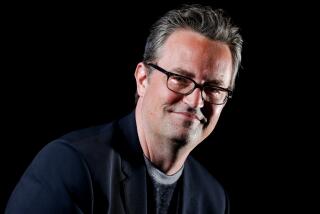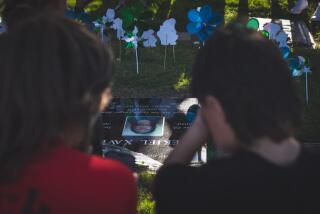Prince’s death casts spotlight on anti-opioid addiction drug

- Share via
It was an intervention that never happened, and it featured two stars: Prince, an adored music icon, and buprenorphine, an obscure drug hailed as a revolutionary tool to fight opioid addiction.
Prince died before the first scene, when a drug-addiction consultant, a physician and Prince’s associates converged on the star’s Paisley Park home near Minneapolis, based on official accounts. The plot twist? The consultant, Andrew Kornfeld of the Recovery Without Walls clinic in Mill Valley, Calif., was carrying a small amount of buprenorphine. Nicknamed “bupe,” it is also known by several commercial names including Suboxone.
Dr. Howard Kornfeld, the founder of the Recovery Without Walls clinic (and Andrew’s father) is a leading proponent of the drug as a means of curbing opioid addiction. Dr. Kornfeld and his son declined to be interviewed.
See more of our top stories on Facebook >>
But their attorney, William Mauzy, told reporters following Prince’s April 21 death that Andrew Kornfeld had flown to Minneapolis in hopes of encouraging Prince to check himself into the Mill Valley rehabilitation center and that the buprenorphine he was carrying was intended to be turned over to a Minneapolis physician to be administered to the late pop star. According to Mauzy, the medication was not administered and was later taken into possession by sheriff’s investigators.
While the cause of Prince’s death in the early-morning hours of April 21 is still being investigated, both state and federal authorities are trying to determine if prescription drugs played any role. That probe in turn has shined a spotlight on buprenorphine.
Why an addiction treatment center in California was contacted on Prince’s behalf, rather than one closer to his home, isn’t known.
Recovery Without Walls is located on the top floor of a two-story office building that also houses a fine arts gallery and optometrist office at the edge of the commercial district of Mill Valley, a town about 12 miles north of San Francisco.
On its website, Kornfeld is described as “a nationally recognized expert in the use of buprenorphine.” Andrew, the son who flew to Minneapolis, was listed in a January 2015 post on the website as the director of new patient services at the center. His LinkedIn page now identifies him as chief executive of PractionerPlus, a year-and-a-half-old marketing firm for medical enterprises.
The Recovery Without Walls website notes, “When acute detoxification treatment is required, we arrange 24-hour nursing care, supervised by Dr. Kornfeld.” Kornfeld, who has published scholarly papers on aspects of buprenorphine, according to the website, recently was scheduled to speak about the drug at a conference of the American Pain Society. Asked by a Times reporter about the Prince case, Dr. Kornfeld said, “I am not making any statement at this time.”
About 30,000 physicians have qualified to prescribe buprenorphine, but each doctor is limited to 30 patients in his or her first year and 100 thereafter, according to the National Alliance of Advocates for Buprenorphine, a nonprofit advocacy group that runs a doctor-matching site for those seeking the treatment. Only about a third of the certified physicians are writing prescriptions, the group says.
Advocates of buprenorphine say those limits on the number of eligible patients doctors can treat are among several obstacles keeping thousands of addicts from getting treatment, leaving them vulnerable to overdose on opioids and creating a black market for the drug.
“Buprenorphine is one of the most effective treatments we have for opioid addiction,” said Julie Netherland, academic engagement director for the Los Angeles-based Drug Policy Alliance, which is pushing for expanded use of buprenorphine.
Others say the drug has created another nightmare of dependency. Some doctors and patients say buprenorphine has proved harder to quit than other substances that got people addicted in the first place.
“It’s a two-week withdrawal on average and it’s significantly worse than heroin, in my experience,” said addiction therapist and television host Dr. Drew Pinsky, who chooses not to prescribe buprenorphine, though he has referred clients to physicians who do.
Buprenorphine is one of the most effective treatments we have for opioid addiction.
— Julie Netherland, academic engagement director for Los Angeles-based Drug Policy Alliance
Pinsky said buprenorphine “has its use” in the short-term treatment of opioid addiction but cautions that “it’s the enthusiasm and the skill with which we apply the treatment that I’m gravely concerned about.”
Dr. Chinazo Cunningham, an addiction specialist at Albert Einstein College of Medicine and Montefiore Medical Center in the Bronx, N.Y., agrees with Pinsky. She says buprenorphine shouldn’t be the only recourse for treating opioid-addicted patients.
“Using medication to treat addiction is important, and medication has the best outcome. There’s tons of studies that show that. But you need more than medication. You have to change behaviors,” Dr. Cunningham said. “So, even though the medication works really well, people still have to do the work.”
Buprenorphine gives doctors another option to stabilize a patient for treatment, Dr. Cunningham added.
“Patients have definitely called it a miracle drug and the reality is that for the past 50 years we’ve had only one opiate-agonist medication to treat opiate addiction and that’s really been methadone,” she said. “Now, we have a choice, which is great. But they both have their pros and cons.”
There is very little current data available that shows how many patients have been prescribed buprenorphine, how long they remain on the drug and what the outcome of their treatment was.
Indivior, the drug’s manufacturer, stands by the research that won FDA approval in 2002, even as it tries to moderate the debate.
“When people say wonder drug or silver bullet, I always try and correct them because it’s not,” said Tim Baxter, Indivior’s chief medical officer. “All buprenorphine does is give patients who are motivated to get treatment the clarity to seek treatment.”
The Federal Trade Commission and the Health and Human Services Department launched investigations of the drug’s original manufacturer Reckitt Benckiser Pharmaceuticals (now Indivior) over whether its marketing and other activities related to buprenorphine were illegal and constituted an attempt to maintain its monopoly over a drug that accounts for 80% of Indivior’s $1 billion net revenue. Indivior had no comment regarding the investigations.
Authorities have not released Prince’s cause of death, and an autopsy report is pending. But an attorney who once represented Prince’s deceased half-siblings, Duane and Lorna Nelson, has claimed that Prince was addicted to Percocet, a popular opioid used to treat pain.
The lawyer, Mike Padden, told The Times that the Nelsons asked him to speak on their behalf “to let people know the truth about his situation” in case Prince died — except they died first.
Prince was last seen alive at 8 p.m. April 20, when someone dropped him off at Paisley Park, authorities said. The musician was apparently left alone that night, without staff members or security. The singer, a devout Jehovah’s Witness, was “a very private person,” said Carver County Sheriff Jim Olson at a news conference. “I don’t think it would be unusual, for him to be there by himself.”
When members of his staff couldn’t reach him on the morning of April 21, they went to Paisley Park, where an employee found him unresponsive in an elevator on the first floor. A transcript of a 911 call released by the Sheriff’s Department provided a hint of the frantic scramble that followed.
“Yeah, we need an ambulance right now,” a man, now identified as Andrew Kornfeld, told a 911 dispatcher. “Um, we’re at Prince’s house.... The person is dead here.”
The caller said he didn’t know the address of Paisley Park and apologized for the delay, saying everyone with him was “just distraught.” The dispatcher asked: “Are you with the person who’s — ” The caller responded: “Yes, it’s Prince.”
Yeah, we need an ambulance right now ... Um, we’re at Prince’s house.... The person is dead here.
— Andrew Kornfeld, told a 911 dispatcher.
The U.S. Drug Enforcement Agency is assisting the local sheriff’s office in trying to determine if Prince used painkillers or other controlled medications that should have been obtained from a licensed doctor, or were improperly prescribed to him, a federal law enforcement official told The Times.
Pinsky cautions that even in cases where drugs are properly prescribed and administered, there are limits to their effectiveness in curing drug addiction.
“We need to think about pills that are helpful, that are useful, that have a role to play,” Dr. Pinsky said. “But to think in terms of a pill that takes care of the problem — that is where we get into trouble.”
Times staff writers Matt Pearce, David Ng, Del Quentin Wilber and Peter King contributed to this story.
MORE
Prince’s estate to be temporarily managed by trust company
In Minneapolis, everyone has a story about Prince
Prince had prescription painkillers on him when he died, reports say
In his films, Prince melded music and image into something powerful
At a Jehovah’s Witness hall, congregants remember Prince as ‘Brother Nelson’
UPDATES:
1:43 p.m: This story has been updated to include more information on Andrew Kornfeld’s clinic.
More to Read
The biggest entertainment stories
Get our big stories about Hollywood, film, television, music, arts, culture and more right in your inbox as soon as they publish.
You may occasionally receive promotional content from the Los Angeles Times.











